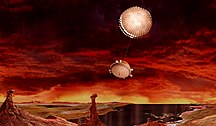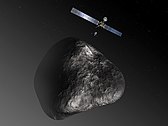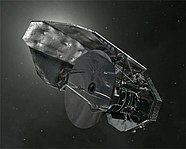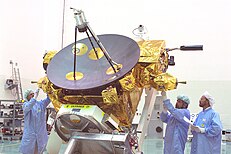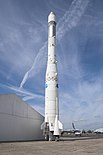欧洲航天局科学计划
欧洲空间局的科学计划(Science Programme)[1][2][a]是一项长期的空间科学和太空探索任务规划,由该机构科学理事会管理,通过制定各十年期航天计划,资助欧洲航天机构和其它组织所开发、发射和运营的任务。首期“地平线 2000”计划在1985年至1995年间推动了包括四项“奠基石任务”—太阳和太阳圈探测器及星簇2号卫星、X射线多镜面牛顿卫星、罗塞塔号和赫歇尔空间天文台等在内的八项任务的开发;第二期“地平线 2000+”计划,在1995年至2005年期间促进了“盖亚任务、激光干涉空间天线开路者号和贝皮可伦坡号的开发;当前的第三期“宇宙愿景”计划,自2005 年来,已资助了十项任务的开发,其中包括三项旗舰任务:木星冰月探测器、先进高能天体物理学望远镜和激光干涉空间天线。目前正在规划即将推出的第四期“远航 2050”计划。另外 ,在科学计划中,还有与欧洲以外航天机构和组织的合作,如与美国宇航局的“卡西尼-惠更斯号”和中国国家航天局的微笑计划项目。
管理
[编辑]| 欧空局科学计划咨询结构[8][9][10] | |||||||||||||||||||||||||||||||||||||||||||||||||||||||||||||||||||||||||||||||||||||||||||||||||||||||||||||||||||||||||||||||||||||||
|---|---|---|---|---|---|---|---|---|---|---|---|---|---|---|---|---|---|---|---|---|---|---|---|---|---|---|---|---|---|---|---|---|---|---|---|---|---|---|---|---|---|---|---|---|---|---|---|---|---|---|---|---|---|---|---|---|---|---|---|---|---|---|---|---|---|---|---|---|---|---|---|---|---|---|---|---|---|---|---|---|---|---|---|---|---|---|---|---|---|---|---|---|---|---|---|---|---|---|---|---|---|---|---|---|---|---|---|---|---|---|---|---|---|---|---|---|---|---|---|---|---|---|---|---|---|---|---|---|---|---|---|---|---|---|---|
| |||||||||||||||||||||||||||||||||||||||||||||||||||||||||||||||||||||||||||||||||||||||||||||||||||||||||||||||||||||||||||||||||||||||
科学计划由欧洲空间局 (ESA) 科学理事会管理[11],其目标包括提升欧洲在太空科学领域的地位、促进技术创新以及维护欧洲太空基础设施,如发射服务和航天器运营[11],为欧空局强制性计划之一,所有欧空局成员国都必须参与[12][13],并按照国民生产净值的比例缴纳一定的会费,以确保该计划及其任务的长期财务安全[14]。该计划的制订过程采用“自下而上”的结构,欧洲科学界可通过咨询机构引导计划的方向[7][15]。这些机构向总干事和科学部主任提出有关该计划的建议[16][17],并可将建议独立报告给欧空局的科学计划委员会(SPC)—整个计划的管理机构[16][18]。该计划目前的咨询结构由天文学工作组 (AWG) 和太阳系与探索工作组 (SSEWG) 组成[8][9],他们向高级空间科学咨询委员会 (SSAC) 报告,该委员会则向该机构的董事会报告[17]。咨询机构的成员资格为期三年[19],天文学工作组和太阳系与探索工作组的主席也是高级空间科学咨询委员会的成员[8][9][19]。另外,还可设立特设咨询小组,就某些任务提案或规划周期的制定提供咨询意见[10]。
该计划中的任务是从欧洲科学界成员向欧空局提交的提案中竞选评出[20],在每次竞选中,欧空局都会概述提案需要满足的各类任务评审标准[21],它们分别是“L”级大型任务、“M”级中型任务、“S”级小型任务和“F”级快速任务,每类任务都有不同的预算上限和实施时间表[5][21]。参选提案随后由天文学工作组、太阳系与探索工作组、欧空局工程师和所有相关的特设工作组进行审查,作为“第 0 阶段”可行性研究的一部分[22][23]。对需要开发新技术的任务,会在研发期间由欧洲空间研究与技术中心的并行测试部门进行审查[24]。研究结束后,在“A 阶段”最多选出三项入围提案,并为每项候选任务制定初步设计[23][25]。然后,科学计划委员会就哪项提案进入“B”到“F”阶段作出最终决定,包括任务中所用航天器的开发、建造、发射和处置[26][27][28]。在 A 阶段,每项候选任务会分配两个相互竞争的承建商来建造航天器,并在 B 阶段选择获选任务的承建商[25][27]。
历史
[编辑]背景
[编辑]欧洲空间局成立于1975年5月,由欧洲空间研究组织(ESRO)和欧洲发射装置发展组织(ELDO)合并而成[29][30][31]。1970年,欧洲空间研究组织的发射计划管理咨询委员会 (LPAC) 决定不执行当时认为超出该组织预算和能力的天文学或行星探测任务[32][33],这意味着所有大型科学任务必须要与其他政府航天机构和组织进行合作[33]。1980年,这一政策得到有效改变,时任欧空局科学部主任恩斯特·特伦德伦伯格(Ernst Trendelenburg)和新成立的决策机构—科学计划委员会 (SPC) 决定选择发射飞越哈雷彗星的“乔托号”侦测任务和“依巴谷”天体测量任务[34][35],加上1983年3月选定的国际紫外线探测天文台[35],成为三项首次用阿丽亚娜空间运载火箭发射的欧洲探索任务,自此使欧洲拥有了自主的发射服务[36][37]。除此之外 ,缺乏长期科学任务计划,以及美国宇航局在国际合作的太阳极地任务(后命名为“尤利西斯号”)预算挫折[38],刺激了长期科学计划的发展。通过该计划,欧空局可在更长时间内独立于其他机构和组织持续地规划任务[38][39]。欧空局科学理事会的决策和咨询结构在该计划成立之前就立即发生了改革。20世纪70年代,欧空局科学咨询委员会(SAC)接替了发射计划管理咨询委员会 (LPAC),就所有科学问题向总干事提供咨询,天文工作组(AWG)和太阳系工作组(SSWG)也直接向总干事报告[40]。20世纪80年代初,欧空局科学咨询委员会(SAC)被空间科学咨询委员会 (SSAC) 取代,后者的任务是向科学部主任报告天文学工作组和太阳系工作组的发展情况[41]。此外,前欧空局科学咨询委员会主席罗杰-莫里斯·博内特(Roger-Maurice Bonnet)于1983年5月接替特伦德伦伯格担任科学部主任[42]。
地平线 2000
[编辑]阐述
[编辑]1983年11月和12月,欧空局根据博内特于1983年底向科学计划委员会提交的社会驱动计划的构想,首次向欧洲科学界公开征集任务提案[44][45][46]。这次征集共产生了68项提案,其中30项属于天文学领域,34项为太阳物理学领域,还有4项其它领域的概念[46][47][48]。并从空间科学咨询委员会、欧洲核子研究中心、欧洲科学基金会、欧洲南方天文台和国际天文学联合会等机构召集相关成员[49],组建了一个由时任荷兰空间研究所主管约翰·布雷克(Johan-Bulek)领导的临时“调查委员会”[50][51],专门审查提交的提案[10][52]。在整个1984年初,调查委员会为一系列任务制定了计划,这些任务划分为三类—实施时间较长,需要两年预算的“奠基石”级任务;需一个年度预算的中型任务和只花费半年度预算的小型任务[53][54]。1984年,科学计划的预算为每年1.3亿欧洲货币单位,并建议在1991年之前每年增加7%,届时预算将固定为每年2亿欧洲货币单位[55]。中型和小型类项目稍后将合并为一个中型类项目,代表花费一半预算的任务[56]。这一类别在内部被称为“蓝色任务”,以它们在公开计划图表中被蓝框表示而命名[56]。该计划最初三项奠基石项目都各自针对某一特定的科学领域,参选提案需致力于填补这一领域[54],而中型任务的目标则有待于与任务提案一起进行竞选[56][57][58]。选定的奠基石项目是彗星采样返回任务、X射线光谱学任务和亚毫米天文学任务[59][60][61]。因财务和技术不足而未选定的基础目标,但调查委员会称具有地平线 2000 计划外机会的项目有太阳探测器、火星探测车和二维干涉测量任务[62]。
1984年6月,调查委员会在威尼斯圣乔治·马焦雷岛召开了最后一次会议,会上向时任欧空局总干事埃里克·奎斯特加德(Erik Quistgaard)和欧洲科学界主要成员提交了“地平线2000”计划[54][63][64]。该计划的广义目标是扩大科学知识,将欧洲建立为空间科学的发展中心,为欧洲科学界提供机会,并促进太空技术产业的创新[65]。会议通过了太阳系工作组提出的第四号奠基石项目—日地科学计划(STSP),该计划由太阳和日光层观测站和星团卫星提案组成,成为地平线2000计划下首批选中发射的任务[66][67]。1985年,奎斯特加德在罗马举行的部长理事会上提出了地平线2000计划并获得批准。到1989年,预算每年只增加5%,而不是要求到1991年达到的7%[64][68][69],这只够为地平线2000目标提供约一半的资金[69]。但1990年海牙部长理事会批准将5%的年增长率延长至1994年,这使得所有地平线2000任务都能获得全额资金[70][71][72]。
实施
[编辑]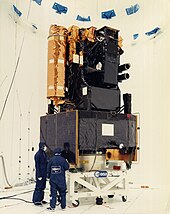
1985年6月,欧空局在灵比举办的一次研究会上,X射线多镜面任务(XMM)被列为X射线光谱学奠基石任务,该任务是一台由12架低能望远镜和7架高能望远镜组成的空间天文台[73]。但受客观条件限制,到1987年,任务有效载荷整体削减至7台望远镜[74]。虽然欧洲X射线天文台卫星(EXOSAT)的成功启发了任务规划者通过将航天器发射到高偏心轨道来提高任务观测效率[75][76],可使航天器的有效载荷减少到最终设计的三架大型望远镜—每架望远镜的反射面积为1500厘米2[75][77]。到1986年,预计第四号奠基石项目—日地科学计划的成本将超出所分配的4亿欧洲货币单位预算[78][79]。在1986年2月的一次会议上,科学计划委员会被告知有可能取消该奠基石项目,以便转为在太阳和日光层天文台、星簇卫星和开普勒火星轨道器提案中选择一项中型任务[78][80],这在空间科学咨询委员会成员中得到了普遍的支持[81]。而一个月前发生的挑战者号航天飞机灾难对该计划产生了极大的负面影响,因为太阳和日光层天文台原计划搭载在航天飞机上发射升空[82]。尽管如此,通过简化太阳和日光层天文台,以及将星团卫星减少为三颗[83][84],太阳系工作组、空间科学咨询委员会和科学计划委员会还是坚持了对日地科学计划项目的承诺。1986年10月与美国宇航局达成的一项合作协议,进一步降低了任务的成本—美国宇航局将提供测试、发射服务和卫星操作,并提供各类科学仪器[85][86],同时取消自已的赤道任务,转而使用搭载了美国探测仪器的第四颗星簇卫星[87][b]。
第一次中级飞行任务是1982年欧空局在地平线2000计划前,从提交的提案中选出的[89],一艘由一组美国和欧洲科学家提出的搭载在美国卡西尼号航天器上的土卫六探测器[89],并与美国-欧洲联合的莱曼紫外线天文学卫星和魁煞甚长基线干涉天文台一起成为最终入围者[90][91][92]。欧洲-苏联联合的维斯塔小行星多次飞越任务和格拉斯普伽马射线天文台也参加了评选[93][94],但被天文学工作组和太阳系工作组拒绝[92][95]。挑战者号失事导致的预算削减迫使美国宇航局撤消了对莱曼和魁煞项目的支持[96]。1988年11月,科学计划委员会选择了土卫六探测器[97],根据会上瑞士天文学家的建议,该探测器更名为惠更斯号,以纪念在1655年发现了土卫六的克里斯蒂安·惠更斯[92]。
在1989年6月的第二次中级任务竞选中,美国和欧洲机构联合提出了国际伽玛射线天体物理实验室,一台结合了格拉斯普与美国核天体物理探测器(NAE)功能的伽马射线天文台[98]。美国核天体物理探测器在当年美国宇航局探索者计划评选中落败[99],但美国宇航局支持这一提案,俄罗斯科学院后来曾提出用质子运载火箭发射它,以换取对该探测器的观测时间[100][101]。尽管很担心美国宇航局对该任务的承诺及资金来源,但在1993年6月,科学计划委员会还是选择了国际伽玛射线天体物理实验室项目[102],并由美国宇航局提供深空网络服务和一台光谱仪[103][104]。作为回应,美国宇航局不通过竞选,直接将国际伽玛射线天体物理实验室项目列为探索者计划任务[105]。对于这一点,加上对为此次任务所设计光谱仪灵敏度的担忧,在美国宇航局的咨询机构中引起了争议[105][106]。1994年9月,欧空局和美国航天局以缺乏财政支持为由,决定终止美国航天局在光谱仪方面的合作[107],法国国家太空研究中心迅速承担了财政负担,并主导了新光谱仪的设计和制造[108]。
1993年11月,罗塞塔号和“福斯特号”入选为第三和第四次奠基石任务[109],后一任务最终被重命名为赫歇尔空间天文台。1996年7月,宇宙背景辐射各向异性卫星和背景各向异性测量(COBRAS/SAMBA)后改名为普朗克卫星,被选为第三次中型任务[110][111]。截至2016年12月,地平线2000任务中尚有四项(包括三项奠基石任务和一个中型任务)仍在运行。
地平线 2000+
[编辑]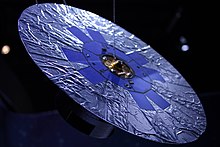
“地平线2000+”是地平线2000计划的延续,为上世纪90年代中期制定的1995年至2015年期间执行的任务计划[112]。它包括了另外两项奠基石级任务,即2013年发射的星际测绘任务盖亚号和2018年发射的贝皮可伦坡号水星探测任务,以及将于2015年发射,以测试未来激光干涉空间天线(莉莎号)的技术演示卫星激光干涉空间天线开路者号,
“地平线2000”和“地平线2000+”计划下的所有任务都取得了成功,只有1996年发射的星簇卫星因火箭爆炸而被毁,但在2000年成功建造并发射了替代的星簇2号卫星。
宇宙愿景
[编辑]宇宙愿景2015-2025是欧空局空间科学任务规划的当前长期计划,最初的构想和概念征集发起于2004年,随后在巴黎举办了一次研讨会,探讨在天文学和天体物理学、太阳系探索和基础物理学等更广泛领域内更全面地定义宇宙愿景的主题。到2006年初,围绕以下4项关键问题制定了10年计划:
2007年3月,正式发布了任务构想征集,共收到19项天体物理学、12项基础物理学和19项太阳系任务建议。
大型
[编辑]大型(L级)飞行任务最初打算与其他合作伙伴联合实施,欧空局设定的费用不超过9亿欧元。然而,在2011年4月,很明显,美国的预算压力意味着在第一项大型任务上不太可能与美国宇航局取得合作。因此,接下来的选择被迫推迟,任务范围重新确定为由欧空局主导,国际参与有限[113]。宇宙愿景计划共选择了三项大型任务,分别为:计划于2023年发射的木星和木卫三轨道飞行器“果汁号”[114];2034年发射X射线天文台“雅典娜号”[115]以及 2037年发射的太空引力波观测台“莉莎号”[116]。
中型
[编辑]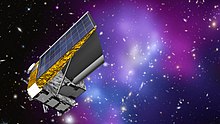
中级(M级)任务是相对独立的项目,成本上限约为5亿欧元。前两项中级任务:近距离太阳观测的太阳物理学轨道飞行器任务[117]和旨在研究暗能量及暗物质的“欧几里德”可见光-近红外太空望远镜任务[118]于2011年10月选出[119]。2014年2月19日,寻找系外行星并测量恒星振荡的“柏拉图号”[120]一举击败回声号(EChO)、阁楼号(LOFT)、马可波罗-R(MarcoPolo-R)和时空探索者与量子等效原理空间测试(STE-QUEST)等空间探测计划,成为第三项中级任务[121]。2015年3月,在对第四次中级飞行任务提案作初步筛选后,6月4日公布了三项入选进一步研究的候选任务名单[122][123][124]:雷神号等离子体天文台、西佩号X射线天文台和系外行星大气红外遥感大调查卫星爱丽儿号。最终,通过观测附近系外行星凌日来确定其化学成分和物理条件的爱丽儿号空间天文台[124],在2018年3月20日被宣布中选第四项中级任务[125][126]。第五项中级任务角逐于2021年6月结束,获胜的展望号金星轨道器将在2031发射升空[127]。斯皮卡号远红外天文台和忒修斯号伽马射线望远镜是此次参选中的另外两项提案[128]。
小型
[编辑]欧空局的小型飞行任务(S级)预算不超过5000万欧元,2012年3月发布了第一次任务提案征集公告,获选的提案需要在2017年前完成发射准备[129],此次征告收到约70份意向书[130]。基奥普斯号是一项通过光度测量搜索系外行星的任务,2012年10月被选为第一项S级任务,将于2019年秋季发射[131][132];2015年6月,欧空局与中国科学院联合开展的地球磁层圈和太阳风交互作用研究项目—微笑任务,从13项竞选提案中脱颖而出, 成为第二项S级任务[133],截至2021年4月,微笑计划将定于2024年11月发射[134]。
快速型
[编辑]在2018年5月16日的欧空局科学计划委员会 (SPC) 研讨会上,提出了创建一系列特殊机会的快速级(F 级)任务。 从第四号中级任务开始,这些快速级任务将与每次的中级任务一起联合发射,并将侧重于“创新实施”,以扩大任务涵盖的科学主题范围。但将快速级任务纳入宇宙愿景计划需要增加科学预算[135]。快速级任务从选择到发射必须在十年时间之内,且重量不超过1000公斤[136]。2019年6月,选出了首个快速级任务-彗星拦截器[137][138]。
机会任务
[编辑]有时,欧空局会资助其它航天机构主持的太空任务。机会任务能让欧空局科学界以相对较低的成本参与合作伙伴主导的任务,设定的成本上限为5000万欧元[139]。欧空局的机会任务包括对日出号、虹膜号、显微镜号、普罗巴3号、X射线成像和光谱学任务(XRISM)、火星太空生物、爱因斯坦探针卫星和火星卫星探测器的资助[139]。对日本宇宙航空研究开发机构的斯皮卡号(宇宙和天体物理学太空红外望远镜)任务的资助虽被评估为宇宙愿景中的机会任务,但它不再在该框架内考虑[140],现已被列为第五号中级任务提案之一。
远航2050
[编辑]欧空局科学计划的下一个十年期规划是“远航2050”,它将涵盖2035年至2050年的空间科学任务。该计划起始于2018年12月任命的高级委员会和2019年3月发表的白皮书公告。[141]。
该计划目前预计有三项大型任务和六到七项中型任务,以及小型和机遇任务[142]。2021年6月11日,高级委员会发布了远航2050计划,并为接下来的三大任务推荐了以下科学主题[143]:
- 巨行星的卫星—探测拥有海洋的气体巨行星卫星的任务。
- 从温和的系外行星到银河系—描述系外行星特征或调查银河系形成历史的任务。
- 早期宇宙的新物理探测器—通过宇宙微波背景、引力波或其他基本天体物理现象来研究早期宇宙的任务。
任务
[编辑]地平线2000
- 奠基石 1 – 太阳和日光层观测站,1995年12月发射,运行中 – 欧空局-美国宇航局为空间天气预报提供实时数据的联合太阳观测任务。
- 奠基石 1 – 星簇卫星,1996年6月发射,失败 – 使用四颗相同卫星研究行星磁层的地球观测任务,发射失败。
- 重新发射– 星簇2号卫星,2000年7月和8月发射,运行中 – 成功完成任务接替。
- 奠基石 2 – X射线多镜面任务,1999年12月发射,运行中 –一架研究宇宙中所有范围X射线源的X射线空间望远镜。
- 奠基石 3 – 罗塞塔号,2004年3月发射,已完成 – 丘留莫夫-格拉西缅科彗星轨道器任务,研究彗星及其演化。
- 奠基石 4 – 赫歇尔空间天文台,2009年5月发射,已完成 –通用天文学红外太空观测任务。
- 中1号 – 惠更斯号,1997年10月发射,已完成 – “卡西尼-惠更斯号”任务的土卫六着陆器组件,首次登陆外太阳系星球。
- 中2号 – 国际伽玛射线天体物理实验室,2002年10月发射,运行中 – 伽马射线空间天文台,也可观测X射线和可见光波长。
- 中3号 – 普朗克卫星,2009年5月发射,已完成 – 绘制宇宙微波背景及其各向异性的宇宙学任务。
地平线 2000 +
- 第1次任务– 盖亚号,2013年12月发射,运行中 – 天体测量任务,测量银河系中超过十亿个天体的位置及距离。
- 第2次任务– 激光干涉空间天线开路者号,2015年12月发射,已完成 –演示宇宙愿景莉莎号引力波观测站技术的任务。
- 第3次任务– 贝皮可伦坡号,2018年10月发射,运行中 – 欧空局-日本宇宙航空研究开发机构联合水星侦测任务,使用两艘分别运行的独特探测器。
宇宙愿景
- 大1号 – 果汁号,2023年8月发射,2031年进入轨道。未来 – 木星轨道飞行器任务,重点研究四颗伽利略卫星木卫二、木卫三和木卫四。
- 大2号 – 雅典娜号,2034年发射,未来 – X射线空间观测任务,用于接替“X射线多镜面任务”望远镜。
- 大3号 – 莉莎号,2037年发射,未来 – 第一次专门的引力波太空观测任务。
- 中1号 – 太阳轨道器,2020年发射,运行中 –太阳观测任务,旨在在0.28天文单位的近日点对太阳进行遥感和原位研究。
- 中2号 – 欧几里得卫星,2023年初发射,未来 – 重点聚焦暗物质和暗能量的可见光和近红外太空观测任务。
- 中3号 – 柏拉图号,2026年发射,未来 – 类似太空观测任务的凌日系外行星巡天卫星,旨在发现和观测系外行星。
- 中4号 – 爱丽儿号,2029年发射,未来 – 研究已知系外行星大气层的红外太空天文台任务。
- 中5号 – 展望号,2031年发射,未来 – 金星测绘轨道飞行器任务[127]。
- 小1号 – 太阳和日光层观测站,2019年12月发射,运行中 –重点研究已知系外行星的空间望远镜任务。
- 小2号 – 微笑计划,2024年11月发射,未来 –欧空局与中国科学院联合执行的地球观测任务,研究地球磁层与太阳风之间的交互作用。
- 快1号 – 彗星拦截器,2029年发射,未来。
时间表
[编辑]
另请查看
[编辑]参考文献
[编辑]注释
- ^ Also known as the ESA Science Programme,[3] ESA's Science Programme,[4][5] or the ESA scientific programme.[6][7]
- ^ Equator was a planned mission by NASA to explore Earth's magnetosphere from an equatorial orbit. It was NASA's contribution to a joint mission with the STSP known as the International Solar-Terrestrial Physics (ISTP) programme.[87][88]
资料来源
- Bonnet, Roger-Maurice; Bleeker, Johan; Olthof, Henk. Longdon, Norman , 编. Space Science – Horizon 2000. Esa's Report to the ... Cospar Meeting (Noordwijk, Netherlands: ESA Scientific & Technical Publications Branch). 1984 [9 July 2019]. ISSN 0379-6566. (原始内容存档于9 July 2019).
- Bonnet, Roger-Maurice. Fundamental science and space science within the Horizon 2000 programme. Rolfe, Erica (编). A Decade of UV astronomy with the IUE satellite: proceedings of a celebratory symposium held at Goddard Space Flight Center, Greenbelt, Maryland, USA, 12-15 April 1988, Volume 2. Noordwijk, Netherlands: ESA Publications Division. 1988: 85–94 [15 July 2019]. Bibcode:1988ESASP.281b..85B. ISSN 0379-6566. (原始内容存档于15 July 2019).
|journal=被忽略 (帮助)
- Bonnet, Roger-Maurice. European Space Science - In Retrospect and in Prospect. Battrick, Bruce; Guyenne, Duc; Mattok, Clare (编). ESA Bulletin No. 81. Noordwijk, Netherlands: ESA Publications Division. 1995: 6–17 [7 July 2019]. ISSN 0376-4265. (原始内容存档于2021-06-04).
|journal=被忽略 (帮助) - Bonnet, Roger-Maurice. Cassini–Huygens in the European Context. Fletcher, Karen (编). Titan: From Discovery to Encounter: Proceedings of the International Conference, 13-17 April 2004, ESTEC, Noordwijk, the Netherlands. Noordwijk, Netherlands: ESA Publications Division. 2004: 201–209 [7 July 2019]. Bibcode:2004ESASP1278..201B. ISBN 9789290929970. (原始内容存档于7 July 2019).
- Cogen, Marc. An Introduction to European Intergovernmental Organizations 2nd. Abingdon, England: Routledge. 2016 [8 July 2019]. ISBN 9781317181811. (原始内容存档于2021-12-29).
- European Science Foundation; National Research Council. U.S.-European Collaboration in Space Science. Washington, D.C., United States: National Academies Press. 1998 [6 July 2019]. ISBN 9780309059848. (原始内容存档于2021-12-29).
- European Space Agency. The Science Programme. The ESA Programmes (BR-114). 1995 [6 July 2019]. (原始内容存档于6 July 2019).
- European Space Agency. How a Mission is Chosen. ESA Science. 2013 [7 July 2019]. (原始内容存档于7 July 2019).
- European Space Agency. Science Programme. ESA Industry Portal. 2015 [6 July 2019]. (原始内容存档于6 July 2019).
- Harvey, Brian. Europe's Space Programme: To Ariane and Beyond. Dublin, Ireland: Springer Science+Business Media. 2003 [9 July 2019]. ISBN 9781852337223. (原始内容存档于2021-05-08).
- Jansen, Fred; Lumb, David; Schartel, Norbert. X-ray Multi-mirror Mission (XMM-Newton) observatory. Optical Engineering. 3 February 2012, 51 (1): 011009–011009–11. Bibcode:2012OptEn..51a1009L. S2CID 119237088. arXiv:1202.1651
 . doi:10.1117/1.OE.51.1.011009.
. doi:10.1117/1.OE.51.1.011009.
- Krige, John; Russo, Arturo; Sebesta, Laurenza. Harris, R. A. , 编. A History of the European Space Agency, 1958 – 1987 (Vol. II - The Story of ESA, 1973 to 1987) (PDF). Noordwijk, Netherlands: ESA Publications Division. 2000 [8 July 2019]. ISBN 9789290925361. (原始内容存档 (PDF)于8 July 2019).
- Wilson, Andrew. ESA Achievements (PDF) 3rd. Noordwijk, Netherlands: ESA Publications Division. 2005 [10 July 2019]. ISBN 9290924934. (原始内容存档 (PDF)于10 July 2019).
引文
- ^ ESA science programme planning cycles. ESA Science. 4 March 2019 [7 July 2019]. (原始内容存档于7 July 2019).
The Science Programme of the European Space Agency (ESA) relies on long-term planning of its scientific priorities.
- ^ ESA 2015,"The Science Programme within the Directorate of Science has two main objectives [...] The Science Programme has a long and successful history..."
- ^ ESA Media Relations Office. ESA Science Programme's new small satellite will study super-Earths. European Space Agency. 12 October 2012 [6 July 2019]. (原始内容存档于6 July 2019).
Studying planets around other stars will be the focus of the new small Science Programme mission, Cheops, ESA announced today. [...] The mission was selected from 26 proposals submitted in response to the Call for Small Missions in March [...] Possible future small missions in the Science Programme should be low cost and rapidly developed, in order to offer greater flexibility in response to new ideas from the scientific community.
- ^ ESA 1995,"ESA's Science Programme has three primary features that single it out among the Agency's activities [...] ESA's Science Programme has consistently focussed on missions with a strong innovative content."
- ^ 5.0 5.1 Call for a Fast (F) mission opportunity in ESA's Science Programme. ESA Science. 16 July 2018 [7 July 2019]. (原始内容存档于7 July 2019).
This Call for a Fast mission aims at defining a mission of modest size (wet mass less than 1000 kg) to be launched towards the Earth-Sun L2 Lagrange point as a co-passenger to the ARIEL M mission, or possibly the PLATO M mission.
- ^ ESA 2013,"The ESA scientific programme is based on a continuous flow of projects that fulfil its scientific goals."
- ^ 7.0 7.1 ESF and NRC 1998,page 36, "The fundamental rule of ESRO, and subsequently ESA, has been that ESA exists to serve scientists and that its science policy must be driven by the scientific community, not vice versa [...] [This] explains the determining influence that ESA's advisory structure has on the definition and evolution of the scientific program."
- ^ 8.0 8.1 8.2 European Space Agency. Astronomy Working Group. ESA Cosmos Portal. 2011 [6 July 2019]. (原始内容存档于6 July 2019).
The Astronomy Working Group (AWG) provides scientific advice mainly to the Space Science Advisory Committee (SSAC). [...] The chair of the working group is also a member of the SSAC.
- ^ 9.0 9.1 9.2 European Space Agency. Solar System and Exploration Working Group (SSEWG). ESA Cosmos Portal. 2011 [6 July 2019]. (原始内容存档于6 July 2019).
The Solar System and Exploration Working Group (SSEWG) provide scientific advice mainly to the Space Science Advisory Committee (SSAC). [...] The chair of the working group is also a member of the SSAC.
- ^ 10.0 10.1 10.2 ESF and NRC 1998,page 36, "还可任命其他临时工作组就特定主题提供咨询意见. [...] 另一个是所谓的调查委员会,该委员会根据欧洲科学共同体提供的投入制定了空间科学长期计划(即地平线2000计划)。"
- ^ 11.0 11.1 ESA 2015,"The Science Programme within the Directorate of Science has two main objectives; To provide the scientific community with the best tools possible to maintain Europe's competence in space; To contribute to the sustainability of European space capabilities and associated infrastructures by fostering technological innovation in industry and science communities, and maintaining launch services and spacecraft operations."
- ^ Cogen 2016,page 221, "All member states must participate in the mandatory programmes [...] Today, ESA's mandatory programmes are carried out under the General Budget, the Technology Research Programme, the Science Programme and ESA's technical and operational infrastructure."
- ^ ESA 1995,"...it is the only mandatory programme [...] In 1975, when ESRO and ELDO were merged to form ESA, it was immediately decided that the Agency's Science Programme should be mandatory."
- ^ ESA 2015,"All Member States contribute pro-rata to their Net National Product (NNP) providing budget stability and allowing long-term planning of its scientific goals. For this reason, the Science Programme is called 'mandatory'.
- ^ ESA 2015,"Long-term science planning and mission calls are established through bottom-up processes. This relies on broad participation, with input and peer reviews of the space science community. The ESA Science Programme is foremost science-driven."
- ^ 16.0 16.1 ESF and NRC 1998,page 36, "They advise the director general and the director of the scientific program on all scientific matters, and their recommendations are independently reported to the SPC."
- ^ 17.0 17.1 European Space Agency. Space Science Advisory Committee (SSAC). ESA Cosmos Portal. 2011 [6 July 2019]. (原始内容存档于6 July 2019).
The Space Science Advisory Committee (SSAC) is the senior advisory body to the Director of Science (D/SCI) on all matters concerning space science included in the mandatory science programme of ESA.
- ^ Cogen 2016,page 219, "The Council is responsible for the establishment of a Science Programme Committee which deals with any matter relating to the mandatory scientific programme."
- ^ 19.0 19.1 ESF and NRC 1998,page 36, "Membership on the advisory bodies is for 3 years, and the chairs of the AWG and SSWG are de jure members of the SSAC."
- ^ ESA 2013,"These projects are identified and selected using the mechanism of the open call. Whenever appropriate, and compatible with the programme goals and constraints, ESA issues a call for proposals for new science missions."
- ^ 21.0 21.1 ESA 2013,"The call includes descriptions of the scientific goals, size, cost of the mission, together with programmatic and implementation details. [...] Missions fall into three categories: small (S-class), medium (M-class) and large (L-class), their size reflecting the scientific goals addressed and eventually the cost and development time required."
- ^ ESA 2013,"ESA's various scientific advisory committees of experts assess the submissions. [...] ESA’s engineers also make an initial assessment of the feasibility of the missions. [...] Phase 0; Mission analysis and identification..."
- ^ 23.0 23.1 Bonnet 2004,page 203, "Following a normal cycle of selection, through the Working Group, ESA undertook a feasibility study in 1984-1985, followed by the selection for Phase A in 1986."
- ^ ESA 2013,"This identifies any new technology that will need to be developed to make the mission possible. The majority of these studies are conducted internally at ESA's Concurrent Design Facility (CDF)."
- ^ 25.0 25.1 ESA 2013,"The committees then make recommendations about which missions should proceed to 'Phase A'. [...] Usually two or three missions are downselected for the phase A study, for which two competitive industrial contracts are placed for each mission. Phase A results in a preliminary design for the mission."
- ^ ESA 2013,"Phase B; Preliminary Definition; Phase C; Detailed Definition; Phase D; Qualification and Production; Phase E; Utilisation; Phase F; Disposal..."
- ^ 27.0 27.1 ESA 2013,"Results are presented, again in Paris to the various committees, and a final decision on which proposal will be selected for each mission is made. [...] They will eventually lead to the 'adoption' of the mission and to the selection of one of the two industrial contractors to become the responsible for the whole implementation phase..."
- ^ Bonnet 2004,page 203–204, "The Titan Probe was eventually selected by ESA's SCP in Nov. 1988 as the first 'blue' mission of Horizon 2000, against four other missions: VESTA, LYMAN, QUASAT, and GRASP."
- ^ Krige et al. 2000,page 34, "The Convention establishing the European Space Agency was signed by ten European states on 30 May 1975 [...] At the same time the Conference of Plenipotentiaries adopted a Final Act including ten resolutions. These made allowance for the transition from ESRO and ELDO to ESA..."
- ^ Cogen 2016,page 217, "ESA is created in its current form in 1975, merging ELDO with ESRO, by the Convention for the Establishment of a European Space Agency of 30 May 1975."
- ^ Parks, Clinton. May 31, 1975: European Space Unites Under the ESA Banner. SpaceNews. 27 May 2008 [8 July 2019].
Established May 31, 1975, ESA formed from the merger of the European Space Research Organisation (ESRO) and the European Launcher Development Organisation (ELDO).
- ^ Krige et al. 2000,page 40, "Astronomy had suffered heavily in ESRO and had been explicitly demoted in priority by the LPAC in 1970."
- ^ 33.0 33.1 Bonnet 2004,page 201, "At their long term planning meeting in 1970, the LPAC decided not to plan any planetary missions because they were considered at the time too expensive and beyond the financial capabilities of ESRO. Cooperation with NASA or the USSR was the only option for Europe to participate in the exploration of the Solar System."
- ^ Bonnet 2004,page 201–202, "The first change from that policy was the proposal of the ESA Science Director, Ernst Trendelenburg, followed by the positive decision of ESA's SPC in 1980, to launch a fast fly-by mission to Halley's comet on the occasion of its return to the vicinity of the Sun in March 1986."
- ^ 35.0 35.1 Bonnet 1995,page 9, "These two events together explain the series of decisions taken between 1980 and 1983. Giotto and Hipparcos were selected by the SPC in 1980 (again with great difficulties in deciding between astronomy and solar-system missions) and ISO in March 1983."
- ^ Bonnet 1995,page 9, "The crisis came in the same period as the arrival of Ariane, which was successfully launched for the first time on Christmas Eve 1979, giving Europe full autonomy in accessing space. [...] All three missions were to use the Ariane launcher and were originally European-only missions."
- ^ Bonnet 2004,page 202, "Giotto (the name given to that mission) was the first purely European mission to explore the Solar System with its own launcher: Ariane 1, launched on July 2 1985."
- ^ 38.0 38.1 Bonnet 1995,page 9, "The ISPM crisis then opened their eyes as they realised for the first time the fragility of agreements signed by their trans- Atlantic counterparts. The Memorandum of Understanding, the official document establishing the basis for the cooperation, which had a binding significance on the European side, had a different interpretation for the Americans, with NASA's budget submitted to yearly discussion at the White House and in Congress."
- ^ Bonnet 1995,page 10, "In 1983, it became clear that ESA could no longer continue with its existing method of selecting project after project, without a long-term perspective and some kind of commitment that would allow the scientific community to prepare itself better for the future. ESA too needed a long-term programme in space science."
- ^ Krige et al. 2000,page 39, "The DG replaced the LPAC with the SAC (Science Advisory Committee) reporting directly to him on all scientific matters [...] A Life Sciences Working Group (LSWG) and Materials Sciences Working Group (MSWG) were also added to the AWG and SSWG, with all working groups reporting to the DG."
- ^ Krige et al. 2000,page 43, "The SAC, which had previously advised the Director General on all scientific matters, was now transformed into the SSAC (Space Science Advisory Committee). Its role became to advise the Director of Scientific Programmes on activities covered by the AWG and the SSWG."
- ^ Krige et al. 2000,page 43, "The spirited and controversial figure of Ernst Trendelenburg, who had spent almost twenty years in ESRO and then ESA, was replaced as Director of Scientific Programmes on 1 May 1983 by the French space scientist Roger Bonnet, former chairman of the SAC from 1978 to 1980."
- ^ Bleeker et al. 1984,page 3, "Over the past 25 years, space science has progressed from the pioneering and exploratory stage to a firmly established mature branch of fundamental science. The time has come to identify what the main thrusts of European space science should be for the coming decades to consolidate Europe's position in the forefront of scientific development"
- ^ Bleeker et al. 1984,page V, "The study, which led to the long term plan proposed in this document, was initiated by the Director of the Scientific Programme in September 1983 and was coordinated by a Survey Committee composed of scientists from different areas of fundamental science."
- ^ Krige et al. 2000,page 43, "Bonnet presented his idea to a meeting of the SPC in October 1983. The scientific community would be asked to suggest mission concepts which would be assessed by expert teams covering various disciplines in astronomy and the solar system sciences."
- ^ 46.0 46.1 Bonnet 1995,page 10, "Following a Call for Mission Concepts issued in Autumn 1983, to which the European scientific community responded with some 68 proposals (Table 2)..."
- ^ Krige et al. 2000,page 44, "The exercise produced 68 mission concepts, 33 in astronomy and 35 in solar system sciences."
- ^ Bonnet 1995,page 10, "Horizon 2000; 2/11 – 31/12/1983; Astronomy 30; Solar Physics 34; Miscellaneous proposals 4; Total no. proposals 68"
- ^ ESF and NRC 1998,page 36, "The SSAC formed the core of the survey committee. The membership of the survey committee, in addition to the SSAC [...] the European Science Foundation, Centre d'Études et de Recherches Nucléaires (CERN), the European Southern Observatory (ESO), and the International Astronomical Union (IAU)."
- ^ Harvey 2003,page 210, "The Agency adopted a team of scientists under Johan Bleeker and made a call for mission concepts: one that was widely supported (70 were received)..."
- ^ Bleeker et al. 1984,page V, "Johan Bleeker; Chairman of the Survey Committee"
- ^ Krige et al. 2000,page 43, "Their proposals would be evaluated by a Survey Committee which would draw up a global model programme for the years 1985 - 2004."
- ^ Krige et al. 2000,page 44, "The philosophy of Horizon 2000 was to divide projects into three classes: cornerstones, costing two annual budgets, and having long lead times; medium size projects, costing one annual budget, and of the class of then current missions like Giotto, Hipparcos and Ulysses; and low-cost projects, costing 0.5 annual budgets, typically participation in international programmes."
- ^ 54.0 54.1 54.2 Harvey 2003,page 210, "In the end, the committee produced a report called Space Science Horizon 2000, often referred to as Horizon 2000. This adopted the principle of 'cornerstone' missions, projects that will advance space science substantially in distinct areas over a period of many years."
- ^ Krige et al. 2000,page 44, "The overall budget for the programme was set at 200 MAU annually (1983 prices) as from 1991, this level to be achieved by an annual 7% increase over the 1984 budget (about 130 MAU)."
- ^ 56.0 56.1 56.2 Bonnet 2004,page 203, "In addition, Horizon 2000 offered the possibility of introducing at any stage in the selection process, medium-size or 'blue' missions, so-called because they were represented as blue boxes in the original diagram of the plan, whose cost would not be larger than half the value of the yearly budget."
- ^ Bleeker 1984,page 6, "Having established the major missions as the 'cornerstones' of the programme, provisions are to be made within the overall long term programme for a number of typical but as yet unidentified medium and small size missions [...] Detailed identification and selection of these smaller missions will be made at the appropriate time and follow the established competitive procedure."
- ^ Bonnet 1995,page 10, "In addition, the plan also included both small and medium size projects [...] but with no i priori (原文如此) exclusion of disciplines, so that a community not 'served' directly by the Cornerstones could still find a place in responding to the regularly released 'Calls for Ideas'."
- ^ Krige et al. 2000,page 44, "The astronomers selected an X-ray spectroscopy mission intended to build a third generation of observatory-class satellites for high-energy astrophysics. Their second cornerstone was in the field of submillimetre heterodyne spectroscopy [...] As for the solar system scientists, one of their cornerstones built on the achievements of Giotto, involving a mission to primordial bodies (comets and asteroids) with a return of pristine materials."
- ^ Bleeker et al. 1984,page 10–11, "The four cornerstones are: The Solar Terrestrial Programme (STP) [...] A Mission to Primordial Bodies including Return of Pristine Materials [...] A High Throughput X-Ray Mission for Spectroscopic Studies between 0.1- 20 keY [...] A High Throughput Heterodyne Spectroscopy Mission..."
- ^ Bonnet 1995,page 10, "so-called 'Cornerstones' were approved in four domains: solar-terrestrial physics (STSP), comet science (CNSR, now called Rosetta), X-ray (XMM), and submillimetre astronomy (FIRST)."
- ^ Bleeker et al. 1984,page 11, "As a follow-up to these four elements it is already possible to identify beyond the horizon 2004 other major thrusts: these are the Solar Probe and the Heliosynchronous Out of Ecliptic Mission in solar terrestrial physics, the Mars Rover in the planetary area, and, in astronomy, two-dimensional interferometry for high spatial resolution in the visible, infrared (IR) and millimetre (mm) wavelength region. These thrusts are beyond the present programme, for technological and financial reasons..."
- ^ Krige et al. 2000,page 44, "After the expert teams had prepared their reports an historic meeting of leading members of the European space science community on the San Giorgio Island in Venice from 30 May to 1 June 1984 consolidated the choices between them and produced a long-term plan which received the name Horizon 2000."
- ^ 64.0 64.1 Bonnet 1995,page 10, "...a survey committee and several Topical Teams were formed to [...] formulate recommendations to ESA's then Director General Erik Quistgaard, for him to present to the Council of Ministers in January 1985 in Rome."
- ^ ESA 1995,"The programme objectives are to: contribute to the advancement of fundamental scientific knowledge; establish Europe as a major participant in the worldwide development of space science; offer a balanced distribution of opportunities for frontline research to the European scientific community; provide major technological challenges for innovative industrial developments."
- ^ ESF and NRC 1998,page 52, "At the final meeting of the survey committee in May 1984 in Venice, Italy, only three cornerstones were originally foreseen. It was therefore a surprise when a fourth, consisting of the SOHO and Cluster missions, was introduced by the chairman of the Solar System Working Group. [...] This cornerstone was called the Solar-Terrestrial Science Program (STSP)..."
- ^ Krige et al. 2000,page 44, "The second, not foreseen in the original outline, sneaked in at the Venice meeting and covered the fields of solar and plasma physics. It involved combining two existing proposals, SOHO and Cluster."
- ^ Krige et al. 2000,page 44, "..as a result of which those present agreed to increase the level of the mandatory programme by 5% annually in real terms over the period 1985 - 1989."
- ^ 69.0 69.1 ESA 1995,"Carrying out Horizon 2000 required a special financial effort from the Member States, amounting to a progressive budgetary increase of 7% per year from 1985 to a steady state in 1992. The Council meeting at Ministerial Level in Rome authorised a slower progression of 5% a year until 1989, thus affording about 50% of the requested increase."
- ^ ESA 1995,"The realisation of the entire Horizon 2000 plan became dependent on such a progression of 5% a year being maintained until 1994. This progression was granted by the ESA Council in December 1990, thereby opening the way to full implementation of Horizon 2000."
- ^ Bonnet 1995,page 10, "...the ESA science budget was granted an annual increase of 5% above inflation [...] an increment that was to be implemented over ten years."
- ^ Krige et al. 2000,page 44, "This was subsequently extended at the Ministerial Meeting in The Hague to enable the programme to reach a level of almost 217 MAU in 1992 (in 1985 prices)."
- ^ Lumb et al. 2012,page 1, "...culminating in a mission presentation at an ESA workshop held in Lyngby, Denmark in June 1985. In the papers presented at this conference the mission design contained 12 low-energy and 7 high-energy telescopes..."
- ^ Lumb et al. 2012,page 1, "When the report of the telescope working group was delivered in 1987, the consideration of practical constraints had reduced the number of telescopes to a more modest total of 7."
- ^ 75.0 75.1 Lumb et al. 2012,pages 1, 4, "The mission was approved into implementation phase in 1994, and an improved observing efficiency achieved with a highly eccentric orbit allowed the number of telescopes to be reduced. [...] Effective area (1keV); 1500 cm2"
- ^ European Space Agency. XMM-Newton Overview. ESA Science. 4 June 2013 [9 July 2019]. (原始内容存档于9 July 2019).
Following the experience with Exosat, which demonstrated the value of a highly eccentric orbit for long uninterrupted observations of X-ray sources, XMM was to be placed in a 48-hour period orbit using the Ariane 4 launcher.
- ^ Wilson 2005,page 206, "The heart of the mission is the X-ray telescope. It consists of three large mirror modules and associated focalplane instruments held together by the telescope's central tube"
- ^ 78.0 78.1 Krige et al. 2000,page 217, "To this, Bonnet replied that the Executive would offer the SPC the choice between implementing the STSP as a wholeor selecting one of the three projects in competition (SOHO, Cluster and Kepler), but stressed that "if the Executive could implement the STSP Cornerstone within 400 MAU, it would do so unless the SSAC expressed a strong negative opinion on this approach"."
- ^ Krige et al. 2000,page 217, "The supporters of Kepler had a good card in their hands, however, i.e. the high cost of the twin SOHO/Cluster mission, well above the 400 MAU ceiling."
- ^ Harvey 2003,page 211, "Several other mission possibilities were also discussed; for example, a Mars probe (Kepler)..."
- ^ Krige et al. 2000,page 217, "The decision was not however taken without some conflict. One of the new SSAC members, M. Ackerman, did not like the "inferiority situation" in which Kepler had found itself as aconsequence of the introduction of the STSP Cornerstone and insisted that the Mars mission should be maintained in the selection cycle."
- ^ Krige et al. 2000,page 219, "The SPC met on 6 February 1986, in the aftermath of the dramatic accident which had destroyed the Challenger Shuttle, killing its crew (28 January). This event threw a new shadow on the STSP programme: firstly, because SOHO was assumed to be eventually launched on the Space Shuttle..."
- ^ Krige et al. 2000,page 217, "After a dramatic discussion on the various options, the SSAC agreed that an STSP mission consisting of a descoped SOHO and a three-spacecraft Cluster should eventually be pursued..."
- ^ Krige et al. 2000,page 218–219, "The SSWG unanimously agreed to recommend the STSP programme [...] The SSAC, for their part, fully endorsed the SSWG recommendation [...] all SPC delegations finally approved the adoption of the STSP double mission into ESA's Scientific Programme..."
- ^ Krige et al. 2000,page 219, "ESA would also develop the SOHO spacecraft (including payload integration) for which NASA would provide testing, launch services and operations. European and US experiments would be included in SOHO and the first Cluster spacecraft."
- ^ Wilson 2005,page 160, "The Solar and Heliospheric Observatory (SOHO) is a cooperative project between ESA and NASA..."
- ^ 87.0 87.1 Krige et al. 2000,page 219, "In the event, a tentative agreement was reached with NASA in October that year, by which ESA would develop four identical Cluster spacecraft, one of which would be launched by NASA in 1993 into an equatorial orbit, thereby replacing NASA's "Equator" ISTP satellite now cancelled, and the three others would be launched in 1994 (free of charge) on an Ariane-5 demonstration flight."
- ^ Goddard Space Flight Center. Equator-S. Space Science Data Coordinated Archive. [15 July 2019]. (原始内容存档于15 July 2019).
Equator-S is different from NASA's ISTP/EQUATOR spacecraft, which was dropped when the ISTP mission was re-scoped in late 1989.
- ^ 89.0 89.1 Bonnet 2004,page 203, "In response to a call for ideas for new missions released by ESA in 1982, a group of European and US scientists proposed adding a Titan Probe as an element of the US Cassini mission."
- ^ Harvey 2003,page 211, "Also in the melting pot for consideration were an ultraviolet observatory (Lyman), a very long baseline interferometry mission (Quasat)..."
- ^ Krige et al. 2000,page 220, "All three missions under consideration were recommended by the Working Groups for Phase-A study, the Titan probe for the Cassini mission by the SSWG and Lyman and Quasat by the AWG."
- ^ 92.0 92.1 92.2 Bonnet 2004,page 203–204, "The Titan Probe was eventually selected by ESA's SPC in Nov. 1998 (原文如此) as the first 'blue' mission of Horizon 2000, against four other missions: VESTA, LYMAN, QUASAT, and GRASP."
- ^ Bonnet 1988,page 87, "Vesta is a trilateral (USSR, CNES, and ESA) mission to the small bodies of the Solar System [...] Each spacecraft will fly-by a minimum of three asteroids [...] A cometary fly-by will also be included."
- ^ Bonnet 1988,page 93, "GRASP (Gamma-Ray Astronomy with Spectrometry and Positioning) is a fully European project."
- ^ Harvey 2003,page 211, "...a gamma ray observatory (GRASP) and a number of candidates for an asteroid mission (Agora, Vesta)."
- ^ Krige et al. 2000,page 220, "Later on, however, NASA informed ESA that because of budgets cuts, in the wake of the Challenger accident, they could no longer consider the Lyman and Quasat projects for the present."
- ^ Bonnet 2004,page 204, "At the end of the SPC meeting the Director of the Science Programme reminded delegations that the Saturn moon Titan had been discovered in 1655 by the Dutch astronomer Huygens. In response to the Swiss request, he therefore proposed that the European contribution to the American Cassini project henceforth by known as 'Huygens'."
- ^ ESF and NRC 1998,page 54, "The early definition of INTEGRAL attempted to combine the best features of the two earlier gamma-ray missions studied on both sides of the Atlantic [...] In June 1989, in response to the ESA call for new mission proposals, INTEGRAL was proposed jointly [...] on behalf of a consortium of institutes and laboratories in Europe and the United States."
- ^ ESF and NRC 1998,page 54, "The renewed discussions of INTEGRAL in Europe following the rejection of GRASP stemmed in part from the NASA Explorer competition of 1989 in which a U.S. gamma-ray spectroscopy mission, the Nuclear Astrophysics Explorer (NAE), had been selected for a Phase A study but then was not selected for flight."
- ^ ESF and NRC 1998,page 54, "It was envisioned as a fully-shared ESA-NASA partnership, a view supported by NASA Headquarters."
- ^ ESF and NRC 1998,page 54, "In December 1991, the Russian Academy of Sciences offered to provide a Proton launcher, free of charge, as a contribution in exchange for a share of the observing time."
- ^ ESF and NRC 1998,page 55, "Moreover, NASA had no previously identified INTEGRAL in its overall mission planning. Given this uncertainty, NASA was unable to make a firm commitment. [...] A suspicion arose within the U.S. space science community that funding the spectrometer would require funds be derived from the Explorer line."
- ^ ESF and NRC 1998,page 55, "At ESA's June 1993 meeting, the SPC approved INTEGRAL as ESA's M2 mission, based on an international cooperation in which Russia would provide the Proton launcher and NASA the spectrometer instrument, as well as a contribution to the ground segment."
- ^ Wilson 2005,page 236, "Integral was selected by the Agency's Science Programme Committee in 1993 as the M2 medium-size scientific mission. It was conceived as an observatory, with contributions from Russia (launch) and NASA (Deep Space Network ground stations)."
- ^ 105.0 105.1 ESF and NRC 1998,page 55, "The INTEGRAL mission had still not garnered broad U.S. support or a vocal constituency in the NASA space science advisory process for several reasons [...] the perception that INTEGRAL had never passed the required peer review in the Explorer competition..."
- ^ ESF and NRC 1998,page 55, "...early concerns of some astrophysists that the lack of detection of bright descrete sources of line emission [...] implied that the spectrometer planned for INTEGRAL might not be sensitive enough."
- ^ ESF and NRC 1998,page 55, "...it became increasingly clear that NASA could not support INTEGRAL at the $70 million level expected by U.S. PIs. [...] Finally in September 1994, a meeting between ESA and NASA led to the conclusion that NASA could not support the U.S. spectrometer PI."
- ^ ESF and NRC 1998,page 55, "The proposal was made possible because the Centre National d'Études Spatiales (CNES), the French national space agency, agreed to assume the financial burden resulting from NASA's withdrawal on the spectrometer..."
- ^ ESA confirms ROSETTA and FIRST in its long-term science programme. XMM-Newton Press Release. 8 November 1993: 43 [21 December 2016]. Bibcode:1993xmm..pres...43.. (原始内容存档于21 December 2016).
- ^ Van Tran, J. Fundamental Parameters in Cosmology. Paris: Atlantica Séguier Frontières. 1998: 255 [2021-12-13]. ISBN 978-2-86332-233-8. (原始内容存档于2021-12-29).
- ^ History of Planck - COBRAS/SAMBA: The Beginning of Planck. ESA Cosmos Portal. European Space Agency. December 2013 [25 December 2016]. (原始内容存档于25 December 2016).
- ^ Vincent Minier; et al. Inventing a Space Mission: The Story of the Herschel Space Observatory. International Space Science Institute (Springer Publishing). 26 November 2017: 40 [2021-12-15]. ISBN 978-3-319-60023-9. (原始内容存档于2021-12-16).
- ^ New approach for L-class mission candidates. ESA. 19 April 2011 [23 August 2019]. (原始内容存档于2019-08-23).
- ^ ESA Science & Technology - JUICE. ESA. 8 November 2021 [10 November 2021]. (原始内容存档于2019-09-21).
- ^ Athena: Mission Summary. ESA. 8 November 2021 [10 November 2021]. (原始内容存档于2021-11-10).
- ^ LISA: Mission Summary. ESA. 8 November 2021 [10 November 2021]. (原始内容存档于2021-11-10).
- ^ Solar Orbiter: Summary. ESA. 20 September 2018 [19 December 2018]. (原始内容存档于2019-02-12).
- ^ Key milestone for Euclid mission, now ready for final assembly. ESA. 18 December 2018 [19 December 2018]. (原始内容存档于2019-08-17).
- ^ Dark and bright: ESA chooses next two science missions. ESA. 4 October 2011 [23 August 2014]. (原始内容存档于2019-08-17).
- ^ Gravitational wave mission selected, planet-hunting mission moves forward. ESA. 20 June 2017 [20 June 2017]. (原始内容存档于2017-07-09).
- ^ ESA selects planet-hunting PLATO mission. ESA. 19 February 2014 [11 February 2015]. (原始内容存档于2019-02-28).
- ^ Call for a Medium-size mission opportunity in ESA's Science Programme for a launch in 2025 (M4). ESA. 19 August 2014 [23 August 2014]. (原始内容存档于2019-08-17).
- ^ Amos, Jonathan. Europe drops asteroid sample-return idea. BBC News. 18 March 2015 [16 April 2015]. (原始内容存档于2021-12-17).
- ^ 124.0 124.1 Three candidates for ESA's next medium-class science mission. ESA. 4 June 2015 [4 June 2015]. (原始内容存档于2019-08-23).
- ^ ESA's next science mission to focus on nature of exoplanets. ESA. 20 March 2018 [23 August 2019]. (原始内容存档于2019-09-13).
- ^ Cosmic Vision M4 candidate missions: Presentation Event. ESA. 5 May 2017 [19 September 2017]. (原始内容存档于2019-08-17).
- ^ 127.0 127.1 ESA selects revolutionary Venus mission EnVision. ESA. 10 June 2021 [11 June 2021]. (原始内容存档于2021-12-25).
- ^ ESA selects three new mission concepts for study. ESA. 7 May 2018 [10 May 2018]. (原始内容存档于2019-10-13).
- ^ Call for a small mission opportunity in ESA's science programme for a launch in 2017. ESA. 9 March 2012 [20 February 2014]. (原始内容存档于2013-03-13).
- ^ S-class mission letters of intent. ESA. 16 April 2012 [20 February 2014].
- ^ CHEOPS Mission Status & Summary. University of Bern. July 2018 [2 November 2018]. (原始内容存档于2019-08-13).
- ^ Exoplanet mission launch slot announced. ESA. 23 November 2018 [19 December 2018]. (原始内容存档于2019-04-18).
- ^ ESA and Chinese Academy of Sciences to study SMILE as joint mission. ESA. 4 June 2015 [5 August 2015]. (原始内容存档于2019-08-13).
- ^ SMILE. Open University. 14 April 2021 [18 May 2021]. (原始内容存档于2021-12-10).
- ^ Hasinger, Günther. The ESA Science Programme - ESSC Plenary Meeting (PDF). ESA. 23 May 2018 [8 July 2018]. (原始内容存档 (PDF)于2021-06-04).
- ^ Gater, Will. Comet mission given green light by European Space Agency. Physics World. 21 June 2019 [23 August 2019]. (原始内容存档于2021-12-15).
- ^ Lakdawalla, Emily. ESA to Launch Comet Interceptor Mission in 2028. The Planetary Society. 21 June 2019 [23 August 2019]. (原始内容存档于2019-11-20).
- ^ O'Callaghan, Jonathan. European Comet Interceptor Could Visit an Interstellar Object
 . Scientific American. 24 June 2019 [23 August 2019]. (原始内容存档于2021-12-15).
. Scientific American. 24 June 2019 [23 August 2019]. (原始内容存档于2021-12-15).
- ^ 139.0 139.1 Policy for Missions of Opportunity in the ESA Science Directorate. ESA. 5 February 2019 [26 June 2019]. (原始内容存档于2019-07-29).
- ^ SPICA - A space infrared telescope for cosmology and astrophysics. ESA. 19 February 2014 [20 February 2014]. (原始内容存档于2013-05-12).
- ^ Voyage 2050 – Long-term planning of the ESA Science Programme. ESA. 28 February 2019 [26 June 2019]. (原始内容存档于2022-01-01).
- ^ Call for White Papers for the Voyage 2050 long-term plan in the ESA Science Programme (PDF). ESA. 4 March 2019 [26 June 2019]. (原始内容存档 (PDF)于26 June 2019).
- ^ Voyage 2050 sets sail: ESA chooses future science mission themes. ESA. 11 June 2021 [12 June 2021]. (原始内容存档于2021-12-15).
外部链接
[编辑]| 机构概要 | |
|---|---|
| 类型 | 航天机构 |

